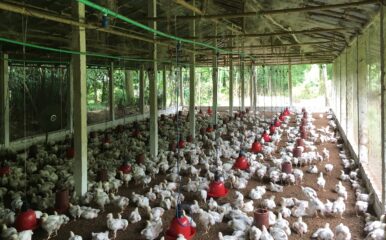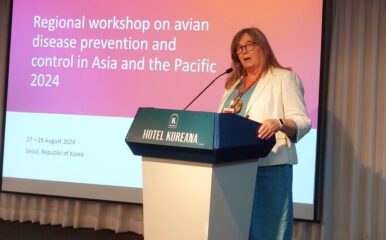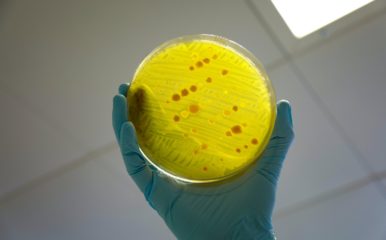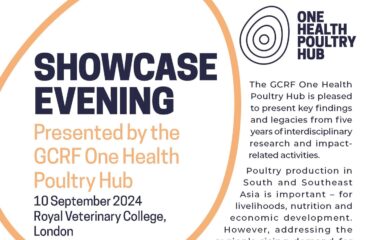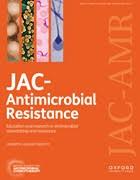
Hub presents findings at multisector meeting to reduce antimicrobial resistance in Vietnam
Published on 31/07/2024
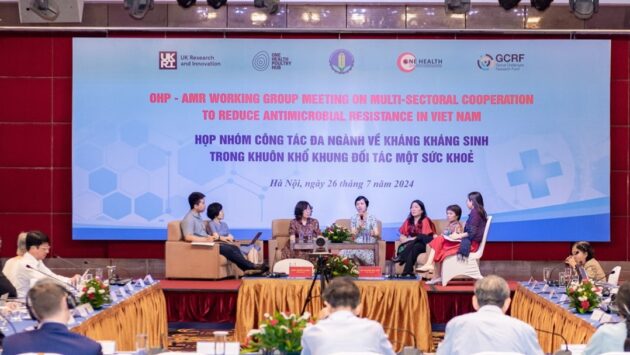
Tran Ngoc Son
View this page in:
VietnameseAn antimicrobial resistance (AMR) working group meeting in Hanoi provided an opportunity to hear updates on the progress of AMR prevention in human, animal and environmental health in Vietnam and share research results of projects in the country.
The meeting brought together relevant sectors including human health, animal health, plant health, environment, and industry and trade, and aimed to enhance the multisector coordination and engagement of the private sector as well as increase public-private partnerships in managing and monitoring antibiotics and preventing AMR.
The event, on 26 July, was the second meeting of the group. It was organised by the One Health Partnership Secretariat of the Ministry of Agriculture and Rural Development (MARD) , and was funded by the GCRF One Health Poultry Hub.
In the opening speech, Dr Nguyen Thu Thuy, Deputy Director of the Department of Animal Health (DAH), said:
Enhancing multisectoral commitment and international cooperation in managing, monitoring and preventing drug resistance is crucial for any nation, particularly Vietnam. The World Health Organization identifies Vietnam as one of the most vulnerable countries with high rates of drug resistance globally. Despite a comprehensive regulatory system for antibiotics and an early national action plan on antibiotics compared to other regional countries, Vietnam faces a need to control drug resistance. This urgent task requires mobilising and investing resources and being implemented effectively.
The event was split into two sessions. The first related to updating AMR management from state management agencies and sharing AMR results of the GCRF One Health Poultry Hub (see boxout below).
The second, including two panel discussions, focused on the advantages and challenges of state management and multisectoral coordination in reducing AMR and how to enhance the role of the private sector in monitoring and implementing tasks related to AMR.
GCRF One Health Poultry Hub researchers Trinh The Hung and Dr Dang Thi Thanh Son presented Hub results as follows.
On reviewing AMR-related regulations
Key findings:
- Regulations related to the production, distribution, use and disposal of antimicrobials in human and veterinary sectors are detailed and follow international standards.
- There are no detailed regulations relating to antimicrobials in waste.
- Regulations related to antimicrobials and AMR can be revised as required to address implementation difficulties. The revised or modified details are sometimes small and dispersed throughout legal texts, making it challenging for individuals, particularly livestock farmers, to recognise.
- Press and media are active in reporting and raising awareness on AMU and AMR, and promoting the NAP.
Recommendations:
- Enhance community promotion of regulations related to antimicrobials.
- Propose a cross-sectoral joint call to fund interdisciplinary research to assess the impact of AMU, including impacts on the environment.
- Develop joint guidelines on strategies to reduce AMU and define legal limits of antimicrobial environmental contamination.
- Ensure all research outputs are incorporated within legal documentation.
On antimicrobial residues and AMR in the broiler meat supply chain
Key findings:
- High prevalence of antimicrobial residues (≥MRL) in chickens in markets (8.6%) and in chickens at the finishing stage in farms (10.2%).
- A high prevalence rate of core AMR genes in Campylobacter and chicken microbiome.
Recommendations:
- Extend the study to other provinces in Vietnam.
- Strengthen consultation and supervision on the prudent use of antibiotics on farms
- Improve knowledge transfer on AMU and AMR in both theory and laboratory practices
- Educate provincial stakeholders and veterinarians on AMR and prudent antibiotic use.
- Complete biosecurity guidelines for farms to ensure food safety of poultry meat for both national and export markets.
State management
Dr Le Thi Hue from DAH updated on results of the National Action Plan (NAP) on AMR for the periods 2017-2020 and 2021-2025. The meeting heard that the following had already been successfully achieved:
- Vietnam has developed national strategies for AMR prevention and a framework for interdisciplinary cooperation.
- Detailed regulations outline the roles, responsibilities and coordination among ministries and departments.
- Each ministry, such as the Ministry of Health (MOH), MARD, and the Ministry of National Resource and Environment (MONRE), has developed a project based on the overarching framework.
- Plans, policy reviews and guidelines on AMR have been documented.
- The national committee and technical working group on AMR are established and now holding meetings.
Challenges to AMR management
The meeting also heard about challenges to AMR management. Implementation and compliance with national strategies are both still limited, and cooperation between the parties has yet to become effective or routine. AMR management also lacks a regular operating mechanism, and although each ministry and sector has its timeframe and priorities there are no shared priorities among them.
In addition, livestock owners and aquaculture farmers have limited awareness and knowledge about antimicrobial use (AMU) and AMR. They often rely on their own experience and that of other farmers’ experience when using antimicrobials.
Research on antimicrobial residues in wastewater and the environment is at an early stage and is not yet systematic.
Combating AMR
The meeting heard that stakeholders contribute to combating AMR in the following ways:
- Academic organisations share research findings with policymakers and stakeholders, and collaborate with policymakers to identify research topics that align with their needs.
- Several drug and feed companies have invested in centres for testing and diagnosing animal diseases to assist farmers with pathogen and antibiotic-sensitivity testing. They also provide free advice to livestock and aquaculture farms on AMU, helping them reduce drug costs and ensure food safety.
- The government works with the private sector on AMR, ensuring its perspectives are taken into account. For example, companies and farmers can obtain a certificate and benefit from their AMR stewardship and monitoring.
The panellists at the meeting, comprising representatives from state organisations and the private sector, made the following suggestions to enhance multisector cooperation on AMR prevention.
- Increase the frequency of national committee and technical working group meetings.
- Discuss and develop a common operating mechanism in which timeframes and priorities are identified among ministries and departments.
- Studies on AMR in the environment should be designed systematically and collaboratively to provide the science needed for policy development.
- Develop guidelines on AMU that link to biosecurity and animal welfare.
The meeting gathered 50 participants offline and 40 online. They included representatives from: four ministries, MOH, MARD, MONRE, and Ministry of Industry and Trade (MOIT); Development partners such as UN Development Programme, Food and Agriculture Organization of the UN and the World Health Organization; and the UK, Australian, US and South Korean embassies. Also USAID, the US Department of Agriculture, the US Animal and Plant Health Inspection Service in Hanoi, FHI 360, CIRAD, International Livestock Research Institute, Oxford University Clinical Research Unit and Woolcock Institute of Medical Research. Private sector participants came from EuroCham, Cargill, De Heus Animal Nutrition, Elanco, VMC Group (Vietnam), Livestock Association and Livestock and Farm Association.
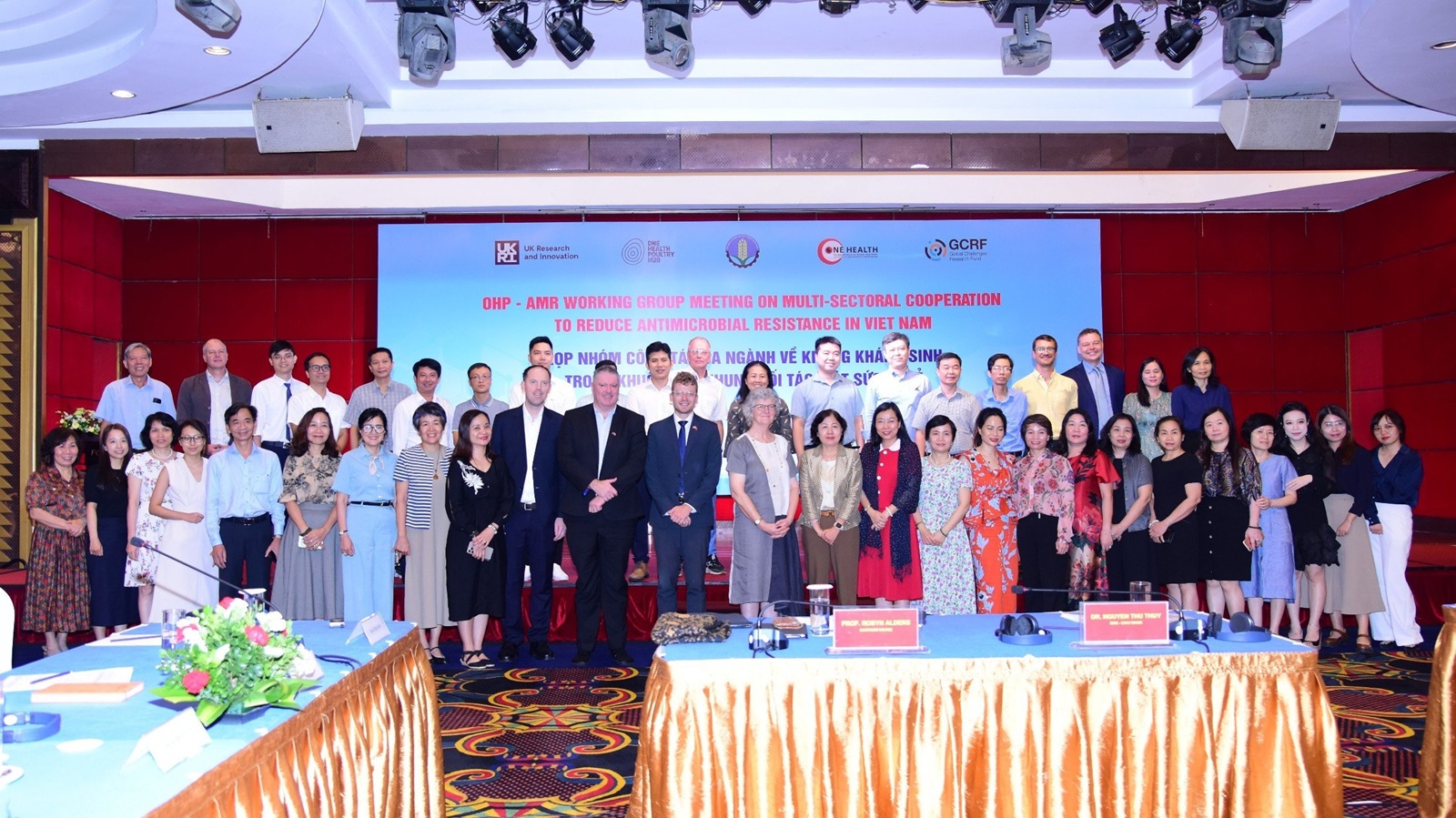
Participants at the AMR working group meeting on multisectoral cooperation in Hanoi. Credit: Tran Ngoc Son
Theme
Location
Language
Area of work
News type
Partner
- Centre de Coopération Internationale en Recherche Agronomique pour le Developpment (CIRAD)
- Department of Animal Health, Ministry of Agriculture and Rural Development
- National Institute of Animal Sciences
- National Institute of Hygiene and Epidemiology
- National Institute of Veterinary Research
- Vietnam National University of Agriculture
- Chatham House

